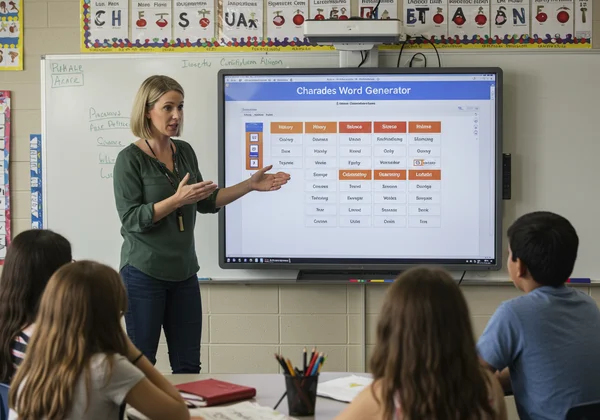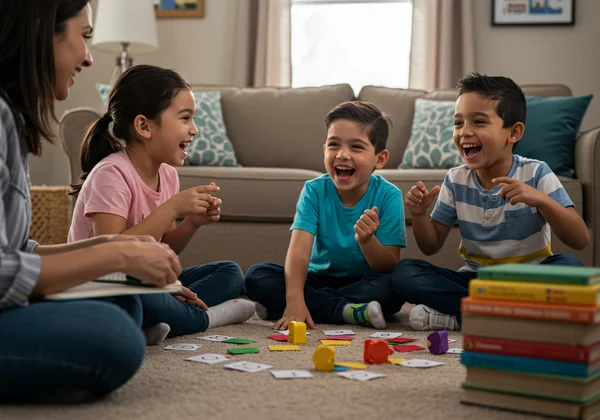Educational Charades Generator: Fun Classroom Learning Games
Are you an educator or parent looking for innovative ways to make learning exciting and memorable? Keeping students focused and motivated can be tough, right? But what if the solution was simpler – and way more fun – than you ever imagined? How can you make learning more exciting and memorable? Discover how educational charades, a classic game of non-verbal communication, can transform your classroom or homeschooling environment into a hub of interactive learning. This guide will show you how this simple game can boost engagement, enhance critical skills, and bring pure joy back into education.
Forget the hassle of preparing materials. With a dynamic charades ideas generator, you can have limitless, curriculum-aligned topics ready in seconds. Let's dive into how you can make your next lesson the most talked-about activity of the year.
Why Educational Charades Transform Classrooms
The magic of charades lies in its ability to turn passive listening into active participation. Instead of simply absorbing information, students are required to process, interpret, and physically express concepts. This isn't just a game; it's a powerful shift from passive listening to active, interactive learning that truly makes a difference. When students are laughing and moving, their brains are also firing on all cylinders, creating stronger neural pathways for memory retention.
Beyond rote memorization, this game helps students build crucial life skills and grow in unexpected ways. It’s a low-cost, high-impact tool that requires no special equipment—just a little creativity and a list of great prompts.

Engaging Students with Interactive Activities
Traditional lectures can often lead to glazed-over eyes and wandering minds. Educational charades shatters this passivity. By getting students out of their seats and performing, you cater to kinesthetic learners who thrive on movement. This active involvement ensures that every student is mentally and physically present. The suspense of guessing and the thrill of performing create a positive, energetic classroom atmosphere where learning feels less like a task and more like a celebration.
Cultivating Essential Skills Through Play
Beyond the academic subject matter, charades is a powerhouse for developing soft skills that are crucial for life-long success. When a student acts out a historical event or a scientific process, they are practicing:
- Critical Thinking: Deciding how to best represent a complex idea without words.
- Problem-Solving: Figuring out clues from a teammate's gestures.
- Creativity: Coming up with unique and clever ways to act out a word.
- Teamwork and Communication: Working together in teams to guess correctly, fostering collaboration and empathy.
These are the skills that build confident, well-rounded individuals, all nurtured through the simple act of playing a game.
Practical Ways to Use Charades as Classroom Games
Integrating charades into your lesson plan is remarkably easy and adaptable to virtually any subject. The key is to align the game's content with your curriculum goals. Instead of random words, you’ll use vocabulary terms, historical figures, book titles, or scientific concepts you are currently teaching. This transforms the game from a simple icebreaker into a powerful tool for review and reinforcement.
With the right resource, you can create these classroom games in an instant. A tool like a free charades word generator allows you to select categories and difficulty levels that perfectly match your lesson's needs.

Tailoring Categories for Specific Lessons
Imagine turning a dry history lesson into a vibrant activity. Instead of just listing facts about the American Revolution, have students act out "Signing the Declaration of Independence" or "Paul Revere's Ride." The possibilities are endless:
- Literature: Act out characters (Sherlock Holmes), titles (The Great Gatsby), or literary devices (metaphor).
- Science: Mime scientific concepts (photosynthesis), elements (helium), or animals (photosynthesis).
- History: Portray historical figures (Cleopatra), events (the moon landing), or landmarks (the Great Wall of China).
- Geography: Guess countries, capitals, or famous landmarks.
You can easily prepare these lists or use a random charades generator to instantly access thousands of ideas sorted by category.
Structuring Charades for Effective Learning
To maximize the educational benefits, a little structure goes a long way. Divide the class into two or more teams to encourage friendly competition. Set a timer for each round—usually 60 to 90 seconds—to keep the pace energetic.
A simple ruleset works best:
- One player from a team draws a word or phrase.
- The player acts it out without speaking or making noise.
- Their team tries to guess the answer before the timer runs out.
- If they guess correctly, they get a point.
- Teams alternate turns.
This structure ensures the game is fair, fast-paced, and focused on the learning objective.
Boosting Language Acquisition with ESL Charades
For students learning a new language, charades is an invaluable tool. It lowers the "affective filter," which is the anxiety that often hinders language production. In a game of ESL charades, the pressure to speak perfectly is removed, allowing students to communicate using their whole body. This physical connection to vocabulary helps cement word meanings far more effectively than flashcards alone.
The multi-language support on our Charades Generator makes it an exceptional resource for ESL and foreign language classrooms, offering prompts in over 15 languages.

Improving Vocabulary & Expressive Skills
When an ESL student has to act out the word "hungry," they connect the abstract term to the physical sensation. This mind-body link is incredibly powerful for vocabulary retention. Likewise, the students who are guessing are hearing the word spoken correctly by their peers and the teacher, reinforcing pronunciation and comprehension in a low-stakes, highly engaging context. The game naturally builds both receptive and expressive language skills.
Making ESL Learning Fun & Accessible
Charades is a universal language. It breaks down barriers and allows students from different linguistic backgrounds to connect and have fun together. The laughter and shared experience build classroom community and confidence. When students see they can successfully communicate an idea even with limited vocabulary, it empowers them to take more risks in speaking, leading to faster language acquisition. It’s a perfect way to make learning both fun and accessible for everyone.
Charades Beyond the Classroom: Homeschooling & Tutoring
The benefits of educational charades extend far beyond the traditional school setting. For parents managing homeschooling or tutors looking for creative teaching methods, this game is a fantastic resource. It's a simple way to break up the day with an activity that is both educational and physically active—a perfect antidote to too much screen time. You can tailor it for one-on-one learning or for a small group of siblings.

Fun & Engaging Activities for Home Learning Environments
In a home learning environment, charades can be used to review spelling words, practice math concepts (acting out shapes or equations), or bring a bedtime story to life. It’s a versatile activity that requires zero prep time, especially when you use an online tool to generate ideas. It fosters a positive association with learning and strengthens family bonds through shared laughter and play. For a quick and easy start, try our free tool today.
Final Thoughts
Ready to transform your educational setting with the power of play? From history and science to language learning, educational charades offers endless possibilities for interactive and memorable lessons. It’s a proven method for increasing student engagement, reinforcing knowledge, and developing essential life skills.
Don't spend another minute struggling to come up with creative ideas. Unlock a world of fun, curriculum-ready prompts instantly with our free online Charades Generator. Choose your subject, select a difficulty, and start making learning fun today!
Frequently Asked Questions About Educational Charades
How can charades be used for educational purposes in a classroom setting?
Charades is a powerful educational tool because it promotes active learning. Instead of passively receiving information, students must process concepts and express them non-verbally. This is excellent for reviewing vocabulary, historical events, scientific terms, and book characters, which reinforces memory through physical action and critical thinking.
What are some good charades ideas for specific school subjects or topics?
The options are limitless! For history, try acting out "building the pyramids." For science, "volcanic eruption." For literature, a character like "Harry Potter." The best way to get tailored ideas is to use a charades generator for kids, where you can select categories like 'Books' or 'Science' to get relevant and age-appropriate prompts instantly.
Can charades help with language learning, especially for ESL students?
Absolutely. Charades is one of the best classroom games for language learners. It lowers the anxiety of speaking, connects vocabulary to physical actions, and improves comprehension in a fun, immersive way. Acting out words like "eating" or "sleeping" creates a strong mental link that flashcards can't replicate.
How do I adapt charades for different age groups in an educational environment?
Adapting charades is simple. For younger children (K-2), use simple, concrete nouns (e.g., "cat," "ball") and actions. For elementary and middle school students, you can introduce more complex concepts, book titles, or historical figures. For high schoolers, use abstract concepts or multi-word phrases. A good online tool will allow you to select "Easy," "Medium," or "Hard" difficulty levels to perfectly match your students' abilities.